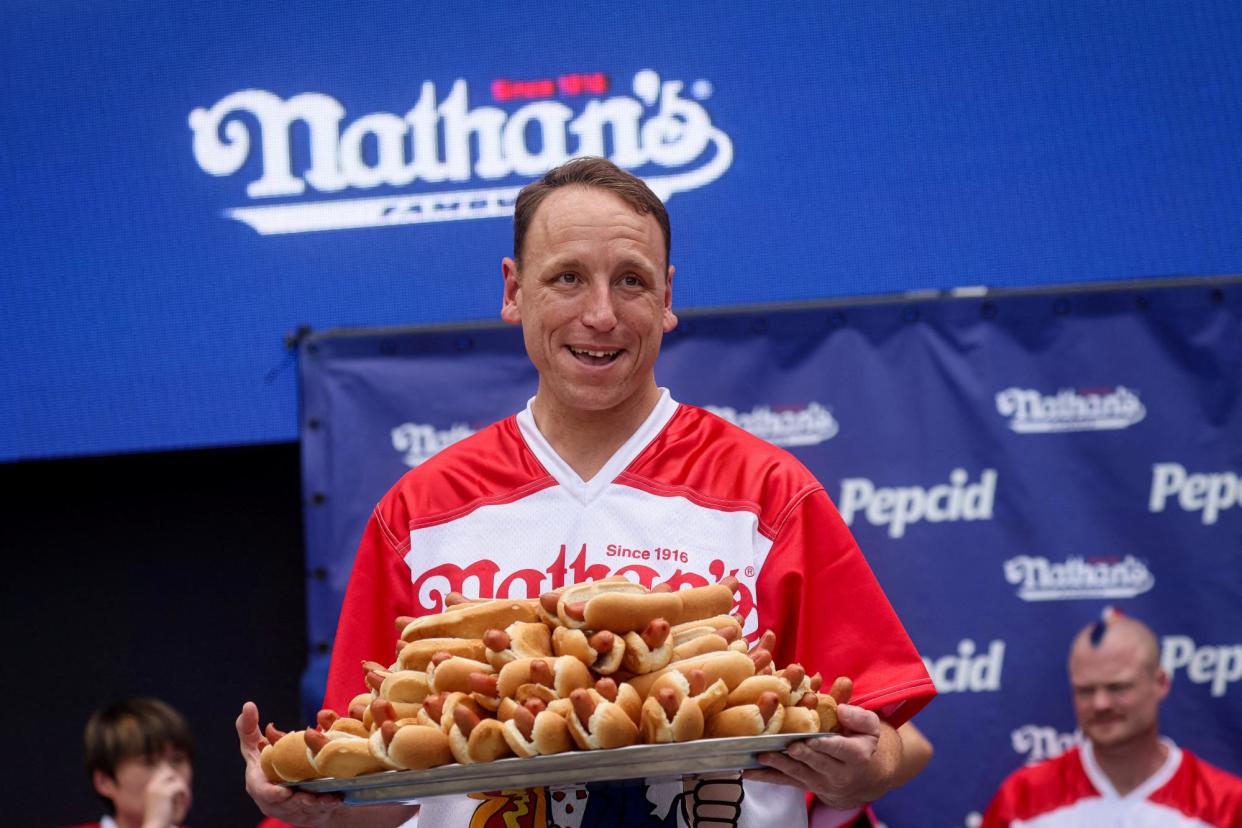Hotdog beef: will ‘greatest eater ever’ really miss Fourth of July contest?

Competitive eating star Joey “Jaws” Chestnut shocked the world of holiday gluttony this week, announcing through representatives that he would not compete at Nathan’s Famous Fourth of July hotdog eating contest on New York’s Coney Island.
The move has not only upset longtime fans of competitive eating, but shone a light on a niche subset of gastronomy and the drama within it.
Chestnut, of Westfield, Indiana, is a 16-time hotdog-eating champion. But he’s not limited to hotdogs – the 40-year-old competitively consumes everything from eggs (141), shrimp wontons (390) to pierogi (165) against an eight-minute competition clock.
Still, it’s hotdogs he’s best known for. Three years ago, he set the record by consuming 76 of Nathan’s dogs in 10 minutes at Coney Island. Major League Eating, which claims to be the world body that oversees all professional eating contests, says Chestnut “is the greatest eater in history.”
Yet Chestnut got himself embroiled in the ultimate face-off when he signed a deal with the plant-based brand Impossible Foods, a perceived slight to his longtime association with Nathan’s.
Chestnut, who is estimated to have earned $4m last year from appearances and endorsements, disputed that it was his choice not to compete in Nathan’s contest next month, saying on X that it was Nathan’s and the Major League Eating world who made the call.
Major League Eating released a statement saying they were “devastated” but “it seems that Joey and his managers have prioritized a new partnership with a different hot dog brand over our long-time relationship”. The organization, it seems, is claiming it did not ban Chestnut.
“Major League Eating wants him there. The fans want him there. Nathan’s wants him there,” the MLE commissioner, George Shea, told WQAM 560 Sports.
Shortly after the revelation that Chestnut was partnering with the vegan food brand, Netflix announced that they would be airing a live hotdog-eating competition featuring Chestnut and his “fiercest rival” Takeru Kobayashi in a special slated for 2 September.
The contest is aptly titled Chestnut vs. Kobayashi: Unfinished Beef.
In the wake of Netflix’s announcement, Shea pushed back against the streamer and said they were “trying to recreate the Nathan’s contest to some extent and you just can’t do that”.
Even New York’s mayor, Eric Adams, has weighed in, writing on X that all parties involved should “stop being such weenies”. He said it would be “impossible” to hold the contest without Chestnut, adding, “Let’s find a way to squash this beef and bring back the champ …”
To understand this bizarre saga adequately, one must take a closer look at this sport.
With its echoes of carnivals, Roman banquets and vomiting – as depicted in Fellini’s Satyricon – and unusual techniques for getting the hotdog down the throat without triggering a gag reflex, it’s easy to see that competitive eating is equal parts thrilling and disgusting.
“It’s definitely an American tradition that comes from the fairgrounds,” says competitive eating coach and homeless housing advocate Neil Thomas. The 42-year-old helped to import the US-centered sport to Dublin, Ireland, where he was billed as “Glutton No 1”.
“In recent years, it’s developed into a serious sport for many people but remains mostly a masculine thing of who can consume the most,” he says.
That’s not to say there aren’t plenty of women who, successfully, compete. Miki Sudo, 38, has won Nathan’s Famous Fourth of July Hot Dog Eating Contest for the women’s division a whopping nine times. Takako Akasaka, one of the most successful female competitive eaters in Japan, holds a record for eating 90 ostrich egg omelettes in Australia. There’s also Carlene LeFevre, who alongside her husband is one of the top ranked members of the International Federation of Competitive Eating, and many, many others.
Regardless of gender, the training is unquestionably rigorous.
“Basically, you have to stretch out your stomach. Some people ingest a lot of water or eat a lot of pasta in a very short period of time. You have to get it into you head to fight the feeling of being full. The faster you eat you can trick your brain into not feeling full, push past the feeling like you’re going to be sick, and keep going …” Thomas said.
Under rules drawn up by the sport’s governing body, the International Federation of Competitive Eating, vomiting, also known as a “reversal” or “reversal of fortune”, can result in disqualification.
“They don’t really talk about it, but it does happen,” Thomas says.
There’s also the question of physique. Competitors like Kobayashi are ripped, while others are a bit softer – but ultimately, the sport involves food and there’s no getting around the obvious pitfalls of eating a lot.
“It’s probably better to be smaller because you don’t have the band of fat restricting your stomach,” he says. “But inevitably in a sport like this you will put on weight.”
Ironically, Thomas points out many eaters aren’t concerned with the food they’re throwing back.
“As it goes down easy and doesn’t involve chewing,” he said. “Pizza is very hard but hot dogs are easy, especially if you flush it [dunk it in water]. The less chewing the better.”
It’s also a sport, he says, that he doesn’t advise anyone train for alone at home given the risk of choking.
As Nathan’s Fourth of July contest approaches, seemingly without Chestnut, Thomas has one piece of advice for those participating to best handle post-competition recuperation.
“Just go to a dark room,” he said, “And think about nothing for about three or four hours and you’re grand.”

 Yahoo News
Yahoo News 
